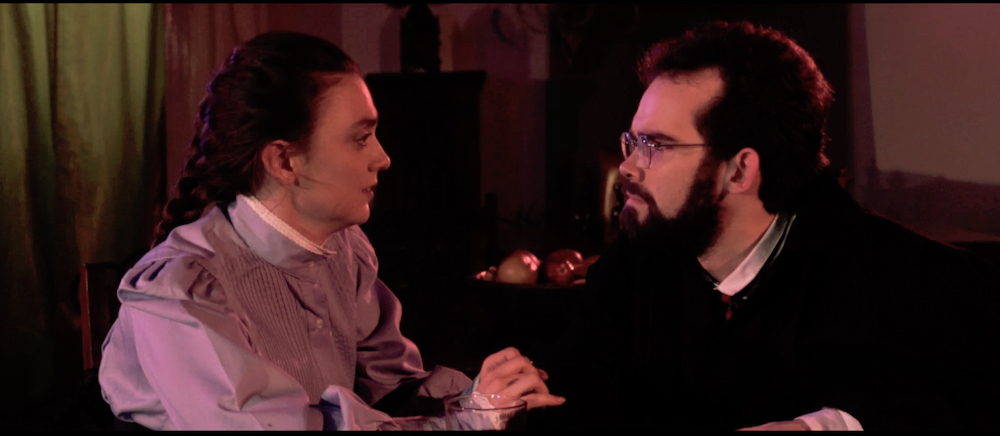Hammer Hath Risen: ‘House of the Gorgon’ Premieres in London

It must have been some elaborate joke…or Facebook, somehow, teasing me mercilessly.
I spotted a post for the London premiere of Joshua Kennedy’s House of the Gorgon on my feed, and two names appeared that took my breath away. Martine Beswicke and Caroline Munro, both veterans of the Hammer Horror (a treasured genre in both British and international filmmaking) and the James Bond series, headlining a film that couldn’t possibly have been produced in 2019 – as opposed to, say, 1969. But there it was. A strikingly neon green and purple-tinged, cult-classic poster evoking the cherished, overcooked melodrama of Hammer was really going to show in London. Two other Hammer veterans also appear: Christopher Neame, who had starred alongside Munro in Dracula A.D. 1972, and Veronica Carlson, who appeared in three Hammer films between 1968 and 1970.
Written, produced and directed by Joshua Kennedy (who appears in a sizeable role), the film is an unabashed love note to a genre wholly abandoned in the cinema-scape. Horror, in its current format, appears to be dominated by bloodthirsty, CGI-generated zombie mannequins or masked hooligans unleashing hell with power tools and kitchen utensils. In outer space. Or after the Apocalypse. To make an impression in the international market, lots of spattering blood capsules and saggy, twisted faces have to reel before us – and more often than not, one or two A-list names should grace the top line of the minimalist teaser posters.
The Hammer Horror series was beloved not merely for its technical wizardry or over-inflated budgets. Quite the contrary. Hammer combined film noir and sci-fi thrillers for both television and feature film, and were often completed for under 100,000 British pounds. For reference, Dracula (1958), was made for £81,412 (which is roughly £1.9 million in 2019) while Jigsaw (2017) came in at $10 million. The films attracted big stars, and they helped to define their careers. The mention of names such as Peter Cushing, Oliver Reed, Ralph Bates and the venerable Sir Christopher Lee all ring with the ominous bells of Hammer Horror in the background. Kennedy, by sheer brass or luck or a bit of both, creates a bona fide Hammer tribute bringing Beswicke out of retirement alongside three other Hammer mainstays.
He had not turned 25 years old.

Kennedy’s education at Pace University from 2013 to 2017, was (to put it mildly) a stimulating change from his upbringing in Edinburg, Texas. Stealing toy video cameras became more than a past-time, and it was his first experimentations in 16mm film at Pace that ignited an already latent spark as a filmmaker. Seasoned professionals such as Frank Martinelli, Jonathan Danzinger and Dr. Catherine Zimmer were his instructors. Classes were small and personalised. Now with sixteen films to his credit, he notes that each successive project was more gutsy than the next, with no fear of weaponised critique or condescension.
“I was always the annoying one asking questions,” he says, “I was never afraid to reach out and play the student.” And to those yet to emerge from their studies, he stresses, “Show your friends, teachers and mentors a rough cut. Don’t be afraid to show a movie that will be laughed off the screen. A lot of students [are] terrified of ideas being stolen…someone said to me, ‘The worst piece-of-crap script on paper is a thousand times better than Citizen Kane in your head.’ What is your view, Mr. Teacher? How can I make it more Gothic Horror? Test audiences are vital.” When it comes to rallying troops to the young filmmaker’s cause, Kennedy says, “In film school where everyone wants to make movies, ask your friend to hold a boom mike, ask if a friend who’s a singer wants to star. If you don’t create a community, what’s the point?” In other words, strength in numbers equals (eventually) numbers with dollar signs in front and credits to your name. “The sooner you’re willing to accept criticism [and collaborate], the stronger you’ll become.”

House of the Gorgon (2019)
Dir. Joshua Kennedy

And now, on to the action. Kennedy places his action in a hollow little town, somewhere in Europe, called Carlstadt. A young woman, Isobel (Georgina Dugdale), arrives with her booze-loving mother (played by Carlson) and her lady-in-waiting, Christina (Jamie Treviño). She arrives to greet her betrothed, Dr. Julian Pritchard (Kennedy), but her party is urged by the local priest (Neame) to abandon the pursuit, and the town, itself. When the women arrive at Pritchard’s estate, they notice that the manor’s grand dame – and Pritchard’s aunt – Baroness Bartov (Munro) is not quite the consummate hostess. She is revealed to be one of the dreaded Gorgons, an ancient Greek demon whose appearance of live snakes for hair could turn men to stone. The second is none other than her sister, Eurayle (Beswicke). The young, sweet-but-salty Isobel must survive the night, and the Gorgons’ lust for virgin blood, so that true love and happiness might be hers.
In short, it’s a film that seems to revel in its low-tech campiness, with a few genuine screen talents holding up the veil of suspended disbelief.










